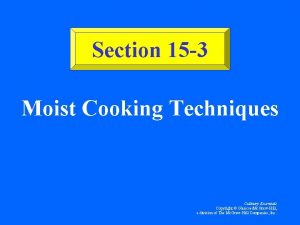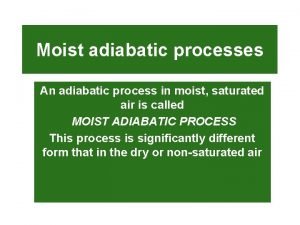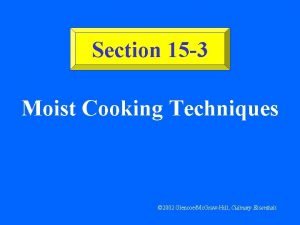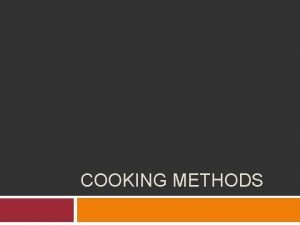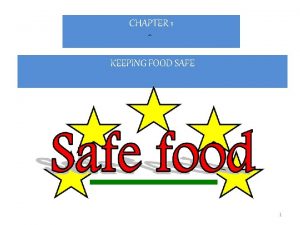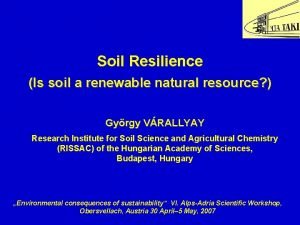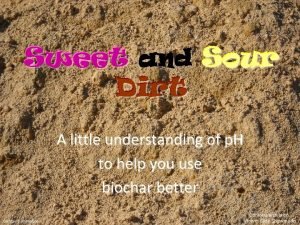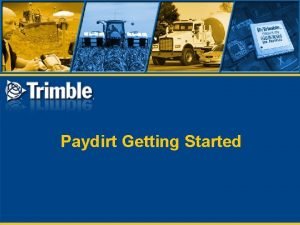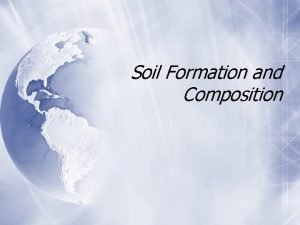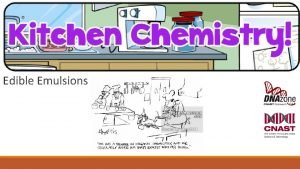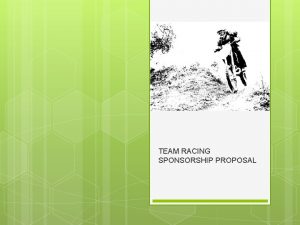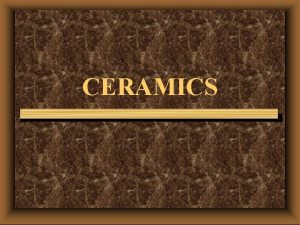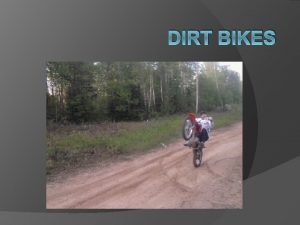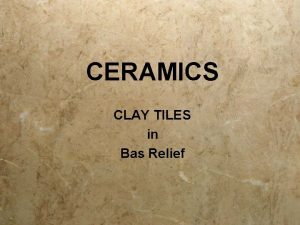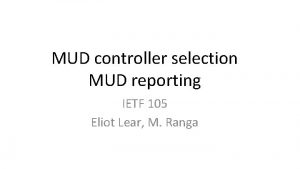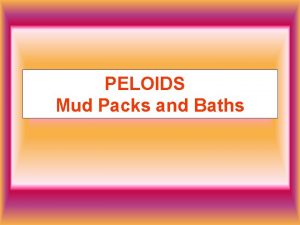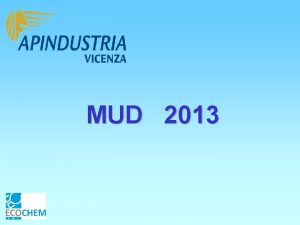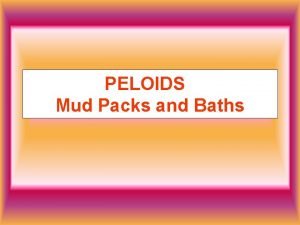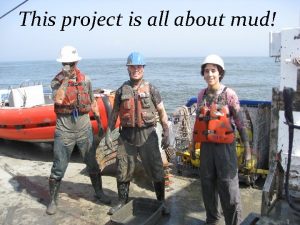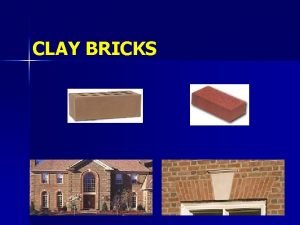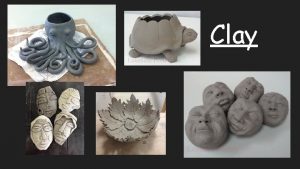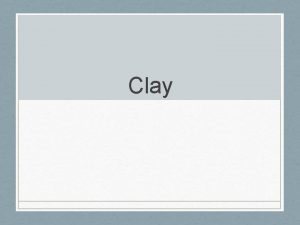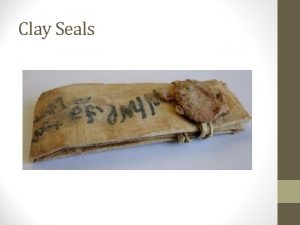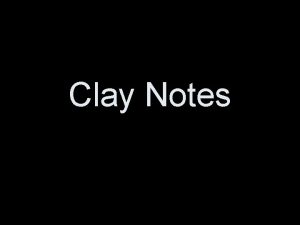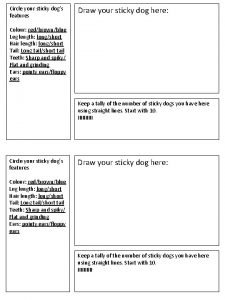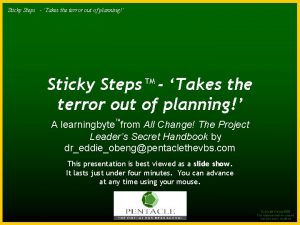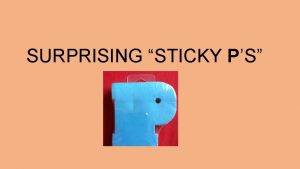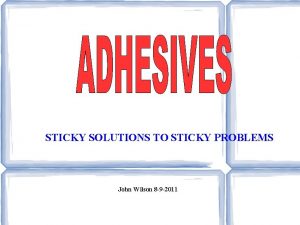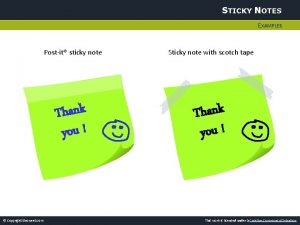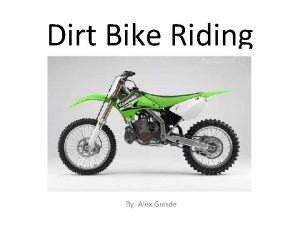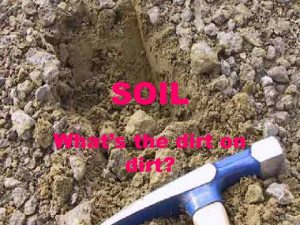CLAY 7 CLAY Mud moist sticky dirt In


























- Slides: 26

CLAY 7

CLAY Mud; moist, sticky dirt. In ceramics, clay is fine-grained, firm earthy material that is plastic when wet, brittle when dry, and very hard when heated. The most common types of ceramic clays are: Earthenware Stoneware Porcelain EARTHENWARE: Earthenware is a low -fire clay that is porous and not waterproof. GREENWARE: Greenware generally refers to unfired pottery.

Working With Clay

PLASTIC: Clay is plastic when it can be easily manipulated - modeled, molded or pressed into a desired shape; malleable. Drying Stages LEATHER HARD: In ceramics, leather hard is a state in which clay has lost moisture to evaporation, but has not yet completely hardened. The clay is damp enough to be joined to other pieces with scoring and slip. BONE DRY: In ceramics, greenware which is thoroughly room dried is said to be bone dry. Ready to be fired.

Clay Building Techniques

TECHNIQUES

WEDGING A technique to make clay plastic and remove air pockets. The clay is thoroughly kneaded and cut before use in modeling or pottery. https: //www. youtube. com/watch? v=GNZhk. HJ 1 oz. E

COILS Long, snakelike ropes of clay that are used in making pottery. The coil method of making pottery involves building the walls of a pot with a series of coils into the required shapes. https: //www. youtube. com/watch? v=DCs. L-Sewqqg

PINCH POTS Pinching is a fundamental pottery technique. Making a pinch-pot is pressing the thumb into a ball of clay, and drawing the clay out into a pot by repeatedly squeezing the clay between the thumb and fingers. https: //www. youtube. com/watch? v=Kjhn. Lu 36 j 4 A

SLAB BUILDING Clay slabs are cut to shape and joined together using scoring and wet clay called slip. Scoring and applying slip to such roughened surfaces creates a bond that holds the pieces together. https: //www. youtube. com/watch? v=12 Q 2 z 61 az. Pg

RELIEF A type of sculpture in which form projects from a background. There are three types of relief: high, low, and sunken. In high relief, the forms stand far out from the background. In low relief (best known as bas-relief), they are shallow. In sunken relief, the backgrounds are cut back and the points in highest relief are level with the original surface of the material being carved.

Putting It All Together

SLIP AND SCORING Adhering clay together. SCORING: Making scratches in pieces of clay to be joined together is called scoring. CLAY SLIP: mixing clay with water makes Slip is a fine, liquid form of clay used with scoring to cement together parts that have been formed separately.

SLIPPING AND SCORING https: //www. youtube. com/watch? v=MYcqti. Cw. K 5 c

Completing the process. . .

FIRING YOUR CLAY • KILN: A kiln is a special oven or furnace that can reach very high temperatures and is used to bake, or fire clay. • FIRING: Firing is the process of baking and hardening pottery. The high temperature fuses the clay particles together, hardening the clay. Temperatures in kilns can reach 2500 degrees. • BISQUE: Bisque clay has been fired once but has not been glazed.

Good Examples. . .




Needs Improvement. . .



Criteria. . .


Fill out your proposal. Leave the selfassessment portion for later. Bring your proposal to me and collect an ice Next Steps Go to: Tombainesclayblog. wordpress. com For more information and tips! cream bucket and clay. Immediately add tape to the lid and bucket and write your name on both. Get a wedge board, water bucket, and sponges, also get wet paper towel for wrapping your clay in later. Begin wedging your clay. If time permits you can begin your design.
 Heat distribution test
Heat distribution test Cooking food in a liquid between 150-185
Cooking food in a liquid between 150-185 Example of adiabatic process
Example of adiabatic process Autoclave empty chamber temperature mapping
Autoclave empty chamber temperature mapping 3 cooking techniques
3 cooking techniques _______is considered as moist method of cooking.
_______is considered as moist method of cooking. Veri moist
Veri moist Cooking methods
Cooking methods Potentially hazardous food is usually moist
Potentially hazardous food is usually moist List of moist heat cooking methods
List of moist heat cooking methods Moist lining
Moist lining Imbalances in earth’s heat energy help to create weather.
Imbalances in earth’s heat energy help to create weather. Dirt bioe
Dirt bioe Is dirt renewable
Is dirt renewable Songs with figurative language lyrics
Songs with figurative language lyrics Vray dirt material
Vray dirt material Sour dirt
Sour dirt Pay dirt software
Pay dirt software Principle of progression in physical education
Principle of progression in physical education The dirt
The dirt What. is. soil
What. is. soil Is dirt abiotic or biotic
Is dirt abiotic or biotic To kill a mockingbird chapter 3 questions
To kill a mockingbird chapter 3 questions Icy dirt
Icy dirt Is oil more dense than water
Is oil more dense than water Are flowers biotic or abiotic
Are flowers biotic or abiotic Racing sponsorship template
Racing sponsorship template

